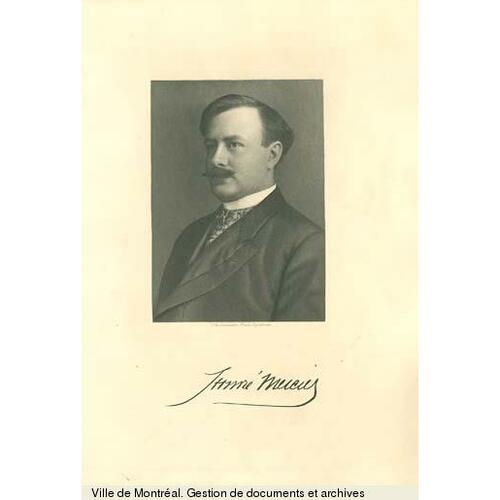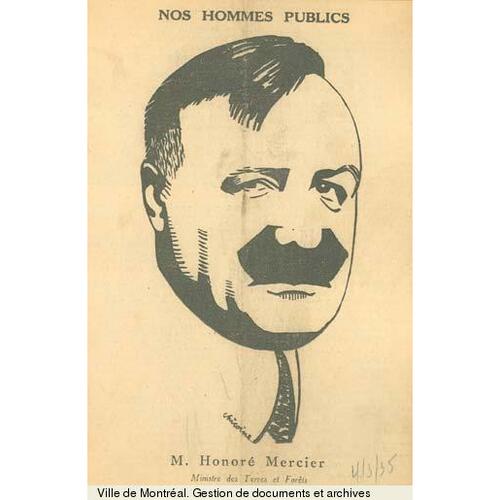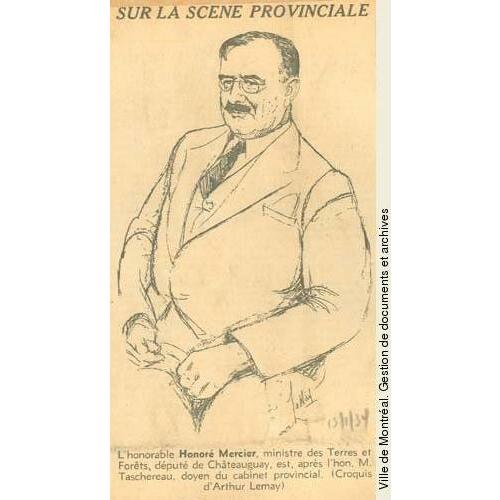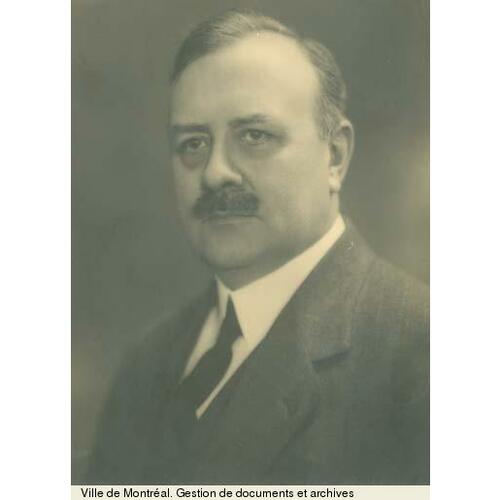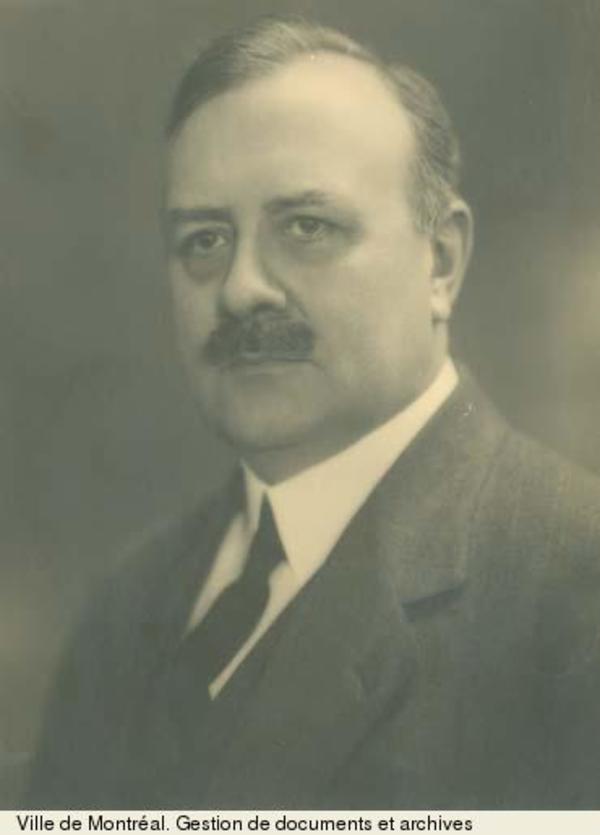
Source: Link
MERCIER, HONORÉ (baptized Joseph-Honoré-Alfred-Édouard), lawyer, politician, and school administrator; b. 20 March 1875 in the parish of Saint-Hyacinthe-le-Confesseur, Saint-Hyacinthe, Que., son of Honoré Mercier* and Virginie Saint-Denis; m. 21 April 1903 Jeanne Fréchette in Montreal, and they had at least ten children; d. 19 June 1937 in Léry, Que., and was buried 23 June in Notre-Dame-des-Neiges cemetery, Montreal.
Honoré Mercier came from a background in which politics was omnipresent. He lived in Saint-Hyacinthe for his first six years and then his family moved to Montreal. His father was a lawyer and the Liberal member for the provincial riding of Saint-Hyacinthe, and he would be premier of Quebec from 1887 to 1891. In 1887 young Honoré started his classical studies at the Collège Sainte-Marie. He left the institution two months before completing the final stage (1893–95) of that program to begin instruction under Alexandre Bonnin, a professor at the École Polytechnique of Montreal. On 8 Dec. 1893 Bonnin certified that Mercier had completed the subjects required to study law and declared his conduct to be irreproachable. The elder Honoré Mercier died of diabetes on 30 Oct. 1894.
On 5 Feb. 1896 Mercier obtained a certificate from the Quebec government authorizing him to begin training in law. He attended the Université Laval in Montreal, which granted him an llb in 1899, and was articled to Thomas Fortin, a lawyer in the same city. He was called to the bar of the province of Quebec on 11 July 1900, and practised law on his own until 1904, when he joined forces with Camille Piché. In the meantime he had married Jeanne Fréchette, daughter of the writer and poet Louis Fréchette*. After working in partnership with his brother-in-law Henri-Alphonse Béïque from 1907 to 1917, he acted alone for five years. He then gave up his practice until 1928. From 1931 to 1936 he was a partner in the firm of Mercier, Blain, Bissonnette et Fauteux. He had been made a kc on 26 April 1913.
On 4 July 1907 Mercier had been appointed to the board of governors of the École des Hautes Études Commerciales de Montréal, an institution recently created by the premier of Quebec, Lomer Gouin*, who was also his brother-in-law. Along with Isaïe Préfontaine, its president from 1907 to 1919, and Auguste-Joseph de Bray, its principal from 1907 to 1916, Mercier played a role in setting up the school. He was secretary-treasurer from 1907 to 1915, and he would remain a member of the governing board until 1921, when the provincial secretary Louis-Athanase David* would replace him.
Like his father, Mercier took an interest in politics. In the Montreal municipal contest of 1906, he was elected councillor for Centre Ward, an office he would hold until 1910. Mercier’s concerns while he was on the council included burying power lines and creating a large library for the metropolis. Following the resignation of the Liberal mla François-Xavier Dupuis in 1907, Mercier ran in the provincial riding of Châteauguay. He won the by-election of 16 December, defeating the Conservative Nationaliste, Joseph-Magloire Laberge, by 233 votes. He lost his seat following the general election of 8 June 1908, but regained it in a by-election on 28 December and would hold it until 1936. Because of his family background, he sometimes found himself in awkward situations such as the occasion in 1909, when Gouin had a controversial bill passed to erect a monument to the memory of the elder Mercier. It was unveiled on 25 June 1912 near the Quebec legislative buildings.
On 29 April 1914 Mercier accepted the post of minister of colonization, mines, and fisheries, which he would retain until 25 Aug. 1919. He played a role in the preliminary steps leading to the adoption of the 1916 Convention between the U.S. and Great Britain (for Canada) for the protection of migratory birds. In 1917, in Le Naturaliste canadien, he pointed out that his department was one of the first to have promoted, in December 1913, the protection of migratory birds. Despite the opposition’s sarcastic remarks, the law setting aside certain areas of the province of Quebec as bird sanctuaries was given royal assent on 17 March 1919 thanks to Mercier, who had been its sponsor. Its aim was to create protected zones on parts of Île Bonaventure, on Rocher aux Oiseaux, and on Rocher Percé. In 1918 Mercier turned his attention to the development of Laurentides National Park as a recreational area, and to the creation of the Réserve de Forêt, de Chasse et de Pêche dans la Gaspésie. At the beginning of the 1930s he would attempt to set up a new conservation area in the region of the Ottawa River, but this project would be abandoned when the government of Maurice Le Noblet Duplessis* took office.
Mercier became minister of lands and forests on 25 Aug. 1919. He tried to find a model for the exploitation of natural resources in keeping with the adage of his time: “To govern is to foresee.” At the start of the 1920s he had a hand in setting up a seaplane station in Roberval that was used by surveyor-pilots whose assignment was to produce an aerial map of the rivers and forests and to spot forest fires. In 1922 Mercier encouraged the development of the science of forestry by adding $3,000 to the annual budget of the École d’Arpentage et de Génie Forestier at the Université Laval. In collaboration with the head forester, Gustave-Clodomir Piché*, he helped found the École des Gardes Forestiers at Berthier (Berthierville) and open the Paper-Making School of Three Rivers in 1923.
In his addresses to the Legislative Assembly, the articles he wrote for a diverse audience, and the speeches he delivered in Quebec and the United States, Mercier promoted forest protection. In 1923, on the occasion of a Canadian mission to France on forestry matters, he published in Quebec City a small work, Les forêts et les forces hydrauliques de la province de Québec (released in 1927 as The forests and the waterfalls of the province of Quebec) that demonstrated not only the importance of exploiting resources, but also of taking inventory and conserving them. In other writings, he encouraged the reforestation of the province and deplored excessive cutting. As the 1920s approached, certain ideas circulating in the fields of hydrology and forestry had begun to have an influence on the management of public forests. As a result Mercier noted the effect of the conservation of wooded mountainous areas on the functioning of the water system. On 21 June 1925 and 29 June 1930 he represented the provincial government at the beatification and canonization of Canada’s holy martyrs in Rome.
Mercier’s ideas were progressive. The minister recognized the impact of human activity on nature. Furthermore, he was in favour of women’s suffrage, as was clear in 1927, when he was one of four ministers who supported a bill for this cause. In addition, he promoted the development of hydroelectric power in the province and even hoped that this resource industry would be nationalized [see René Lévesque*].
Mercier also acknowledged the importance of leasing waterfalls to support the construction of hydroelectric stations, including the one at L’Isle-Maligne. Built between 1923 and 1926 at Saint-Joseph-d’Alma (Alma) on the Rivière La Grande Décharge at Lac Saint-Jean [see Sir William Price*], this power station became operational in June 1926 before the properties of landowners in the region had been expropriated. Shortly thereafter, a large number of holdings around Lac Saint-Jean were flooded. The communities of Roberval, Saint-Prime, and Saint-Méthode (Saint-Félicien) were hard-hit. Nearly 800 people applied for compensation. Mercier was aware of the needs of the farmers and afraid that the Liberal government might fall. In 1927, through his efforts, a bill for setting the compensation amounts to be paid because of the water levels raised by the dams at La Grande Décharge and La Petite Décharge of Lac Saint-Jean received royal assent. The statute created the Commission du Lac Saint-Jean whose role was to determine the amount that those affected should receive. It also upheld the right of the company responsible for the power station to continue its operations. At the risk of losing the next election, the government of Louis-Alexandre Taschereau* decided to side with the company. In 1928 Mercier succeeded Joseph-Adolphe Tessier* as chairman of the Quebec Streams Commission. That year there was again heavy flooding on land near Lac Saint-Jean, especially at Saint-Méthode and Roberval. The opposition lost no opportunity to criticize the minister’s political priorities. Consequently, Mercier’s speeches in the Legislative Assembly were among the longest and best documented of his career.
Mercier promoted training in forestry. Following representations made by industrialists and merchants to improve the supply, manufacture, sale, and use of wood, he created the Quebec Forest Products Commission in 1931. Two years later he encouraged the establishment of the École d’Agriculture, a government-controlled institution in Sainte-Martine. In 1934, to improve working conditions in the lumber camps, he helped set up the Quebec Forest Operations Commission.
In June 1936, after the public accounts committee was convened, Taschereau resigned. The rumour that Mercier might replace him as premier had been circulating before the spring session (he was one of the candidates Taschereau favoured as his successor). But Mercier left politics at the end of the month upon the dissolution of the Legislative Assembly. He died on 19 June 1937 at the age of 62 following an attack of angina.
Honoré Mercier combined his love of nature with his legal work and his ministerial responsibilities. When time permitted, he spent his leisure hours in the forested area of the Parc de la Montagne Tremblante at Mont Tremblant. He made a major contribution to the establishment of organizations to study and protect his province’s natural resources. This preoccupation was linked to a movement that had surfaced in North America in the 1920s and 1930s and had created an awareness of the problems caused by resource management.
Among the writings of Honoré Mercier are the following: “La protection des oiseaux insectivores,” Le Naturaliste canadien (Québec), 2e sér., 23 (1916–17): 161–64; “Forest protection and its effect on fish and game life,” American Fisheries Soc., Trans. (Washington), 50 (1920–21): 96–105; “Les forces hydrauliques,” La Vie forestière et rurale (Québec), no.2 (1923): 65–73; and “Comment s’assure la protection des forêts,” La Forêt et la ferme (Montréal), 2 (septembre 1927): 261.
BANQ-CAM, CE602-S1, 11 août 1875; P74. BANQ-Q, P350. FD, Saint-Jacques, cathédrale de Montréal [future paroisse Saint-Jaques-le-Majeur], 21 avril 1903. LAC, MG 27, III, D2. Le Devoir, 21 juin 1937. D. O. Belanger, Managing American wildlife: a history of the International Association of Fish and Wildlife Agencies (Amherst, Mass., 1988). Directory, Montreal, 1904–17, 1931–36. Antonin Dupont, Taschereau (Montréal, 1997). J.‑G. Genest, Godbout (Sillery [Québec], 1996). Pierre Harvey, Histoire de l’École des hautes études commerciales de Montréal (2v., Montréal, 1994–2002), 1 (1887–1926). Raymond Laberge, Les grands Châteauguois, l’honorable Honoré Mercier, fils, 1875–1937 … ([Châteauguay], Québec, 2004). Hector Laferté, Derrière le trône: mémoires d’un parlementaire québécois, 1936–1958, Gaston Deschênes, édit. (Sillery, 1998). Que., Dept. of Agriculture, Report, 1934; Dept. of Colonization, Mines, and Fisheries, Report, 1916–24; Dept. of Lands and Forests, Report, 1916–26; National Assembly, “Quebec dictionary of parliamentary biography, from 1792 to the present”: www.assnat.qc.ca/en/membres/notices/index.html (consulted 28 April 2015); Quebec Forest Products Commission, Report, 1932–35. Québec, Assemblée Nationale, “Journal des débats”: www.assnat.qc.ca/fr/travaux-parlementaires/journaux-debats.html (consulted 28 April 2015). Rumilly, Hist. de la prov. de Québec, vols.33–34. B. L. Vigod, Quebec before Duplessis: the political career of Louis-Alexandre Taschereau, (Kingston, Ont., and Montreal, 1986).
Cite This Article
Yves Hébert, “MERCIER, HONORÉ (baptized Joseph-Honoré-Alfred-Édouard) (1875-1937),” in Dictionary of Canadian Biography, vol. 16, University of Toronto/Université Laval, 2003–, accessed December 31, 2025, https://www.biographi.ca/en/bio/mercier_honore_16E.html.
The citation above shows the format for footnotes and endnotes according to the Chicago manual of style (16th edition). Information to be used in other citation formats:
| Permalink: | https://www.biographi.ca/en/bio/mercier_honore_16E.html |
| Author of Article: | Yves Hébert |
| Title of Article: | MERCIER, HONORÉ (baptized Joseph-Honoré-Alfred-Édouard) (1875-1937) |
| Publication Name: | Dictionary of Canadian Biography, vol. 16 |
| Publisher: | University of Toronto/Université Laval |
| Year of publication: | 2017 |
| Year of revision: | 2017 |
| Access Date: | December 31, 2025 |


